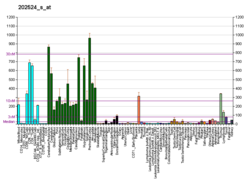| SPOCK2 |
|---|
|
| Identifiers |
|---|
| Aliases | SPOCK2, testican-2, sparc/osteonectin, cwcv and kazal-like domains proteoglycan (testican) 2, SPARC/osteonectin, cwcv and kazal like domains proteoglycan 2, SPARC (osteonectin), cwcv and kazal like domains proteoglycan 2 |
|---|
| External IDs | OMIM: 607988; MGI: 1891351; HomoloGene: 8854; GeneCards: SPOCK2; OMA:SPOCK2 - orthologs |
|---|
| Gene location (Human) |
|---|
 | | Chr. | Chromosome 10 (human)[1] |
|---|
| | Band | 10q22.1 | Start | 72,059,034 bp[1] |
|---|
| End | 72,089,032 bp[1] |
|---|
|
| Gene location (Mouse) |
|---|
 | | Chr. | Chromosome 10 (mouse)[2] |
|---|
| | Band | 10|10 B4 | Start | 59,942,041 bp[2] |
|---|
| End | 59,971,020 bp[2] |
|---|
|
| RNA expression pattern |
|---|
| Bgee | | Human | Mouse (ortholog) |
|---|
| Top expressed in | - paraflocculus of cerebellum
- lateral nuclear group of thalamus
- right hemisphere of cerebellum
- Brodmann area 10
- spinal ganglia
- cerebellar vermis
- middle frontal gyrus
- dorsal motor nucleus of vagus nerve
- Pars compacta
- superior vestibular nucleus
|
| | Top expressed in | - habenula
- entorhinal cortex
- dorsomedial hypothalamic nucleus
- perirhinal cortex
- superior colliculus
- CA3 field
- medial dorsal nucleus
- central gray substance of midbrain
- subiculum
- dorsal tegmental nucleus
|
| | More reference expression data |
|
|---|
| BioGPS | 
 | | More reference expression data |
|
|---|
|
| Gene ontology |
|---|
| Molecular function | - calcium ion binding
- glycosaminoglycan binding
- extracellular matrix binding
- metalloendopeptidase inhibitor activity
- collagen binding
| | Cellular component | - extracellular region
- extracellular matrix
- extracellular space
| | Biological process | - regulation of cell differentiation
- synapse assembly
- peptide cross-linking via chondroitin 4-sulfate glycosaminoglycan
- extracellular matrix organization
- signal transduction
- positive regulation of cell-substrate adhesion
- negative regulation of endopeptidase activity
- positive regulation of cell motility
- cellular response to leukemia inhibitory factor
| | Sources:Amigo / QuickGO |
|
| Orthologs |
|---|
| Species | Human | Mouse |
|---|
| Entrez | | |
|---|
| Ensembl | | |
|---|
| UniProt | | |
|---|
| RefSeq (mRNA) | |
|---|
NM_001134434
NM_001244950
NM_014767 |
| |
|---|
| RefSeq (protein) | |
|---|
NP_001127906
NP_001231879
NP_055582 |
| |
|---|
| Location (UCSC) | Chr 10: 72.06 – 72.09 Mb | Chr 10: 59.94 – 59.97 Mb |
|---|
| PubMed search | [3] | [4] |
|---|
|
| Wikidata |
| View/Edit Human | View/Edit Mouse |
|


















